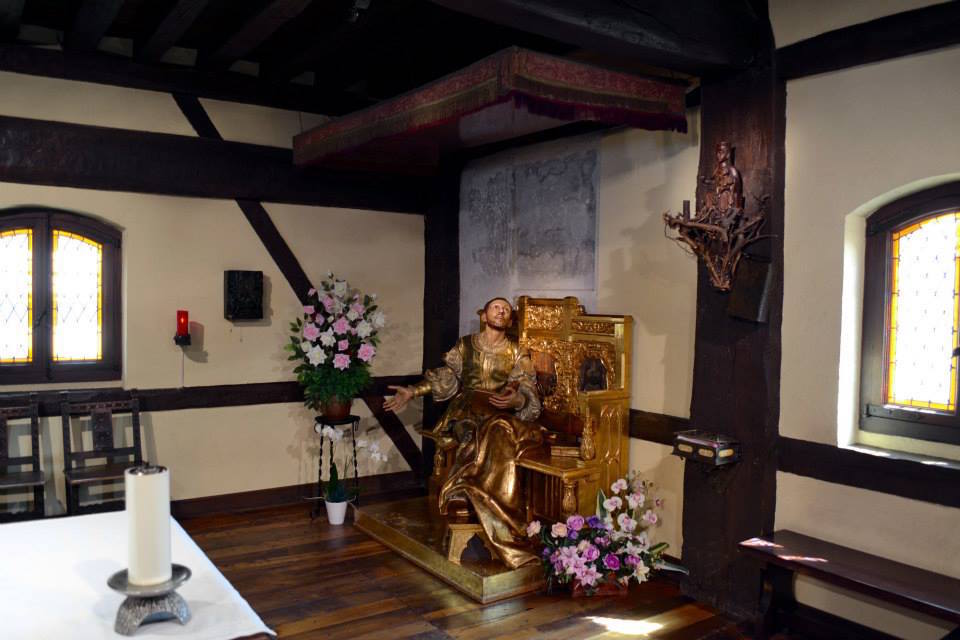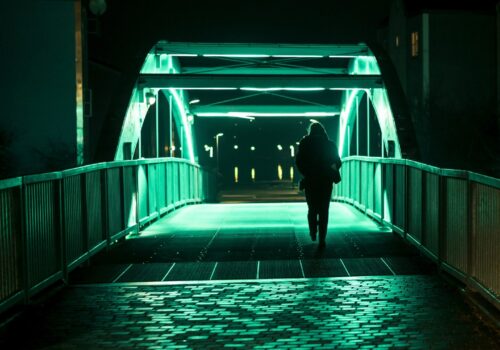LOYOLA, June 27, 2016

Photo: Sarah Stanley, used with permission.
Professor Pham:
Motivation and desire that inspired Ignatius of Loyola to make a pilgrimage did not come easy. Had his leg had not been struck and his bones not crushed during the battle in Pamplona, Ignatius would not have been confined to bed convalescing in Loyola but would have continued his pursuit of “vanities of the world and special delight in the exercise of arms with a great vain desire of winning glory.”[4] Only during this period of immobile convalescence, being pushed to the extreme border between life and death, helpless on his own, removed from the world which he knew, did life alternatives emerge. Possibilities were imagined; new life directions envisioned. He read La Vida de Cristo, a Spanish translation of a work by the Carthusian monk Ludolfo (Rudolfo) de Sajonia (c. 1377-1377/78), and a book of the Lives of the Saints written by a Dominican Friar and translated into Spanish in 1480 and 1511[5] which helped Ignatius to pause and contemplate, “Suppose that I should do what Saint Francis did, what Saint Dominic did?”[6]
Wrestling between his former way of life and new possibilities, between “things of the world” and “going barefoot to Jerusalem and eating nothing but herbs and performing the other rigors he saw that the saints had performed,”[7] Ignatius was first aware of the various interior movements of the spirits that were stirred up in his soul. From this awareness, Íñigo began to discern the bad and the good. Furthermore, he came to realize that it was not he but God who had initiated the encounter, ever so “gently and kindly” awakening holy desires within him.[8] Inflamed with divine love, Ignatius resolved to go to Jerusalem “as soon as he was restored to health undertaking all the disciplines and abstinences.”[9]
Although none of the participants had undergone dramatic bone-crushing injuries or were pushed to the limit of immobile convalescence in the same way that Ignatius had, we both as individuals and as a group were wrestling with our own human limitations and vulnerability on our way to and during our stay in Loyola. One Jesuit student reflected on how the difficulty of negotiating a delayed flight on foreign territory put him in touch with his fear of uncertainty, leading him to pray and to rely on God’s grace at work in the moment. For another Jesuit student, the sudden death of a good friend and Jesuit companion prior to the Camino had left him feeling helpless in grief and sorrow. For a Latina-American student, the anticipation of entering yet another culture both widened and narrowed the space-in-between in her liminal intercultural identity: widening it by being enriched with the best values which each of her cultures offer, narrowing it by being caught in the loneliness from a realization of belonging to none. Looking back, the Camino served as a way for her to contemplate life’s mysteries in a deeper and more active way.
Anxiety and insecurity began to creep in as I watched members of the course assemble in the Jesuit chapel for a blessing before heading to downtown Berkeley to board the train for the airport. No longer dressed in some neat coat and tie walking to the school and meeting students in their casual attire and air conditioned classroom, all of us appeared well-equipped with walking gear and outdoor outfits, eager to get on with the journey. The road would literally become our classroom and we, teachers and students, pilgrims.
Multiple worries and concerns rushed through my heart and my mind at different levels. Feeling of losing control settled in. What would happen if what we had planned all along did not come through? Would students behave the same as they had in class? Their lifestyles, customs, language were so different from mine (our students hailed from countries and cultures as diverse as Kenya, Mexico, the Philippines, the United States, and Vietnam; they comprised lay and religious, women and men). Three weeks walking on the Camino seemed to me, at that moment, like an eternity. What had I gotten myself into? And why? The road ahead seemed reduced into fears that choked up any previous excitement. Fear intensified and anxiety heightened as we wandered at midnight around the parking lot of the Barcelona International Airport after the long transcontinental flight, looking for our Spanish correspondent and guide. The road seemed dark; my spirit immobilized.

Photo: Kathryn Barush
In the bunk bed of the tiny hostel, struggling with the darkness of my fear and anxiety, I stumbled upon the folder of the students’ reflection papers. Slowly and prayerfully, I had a powerful vision of each of their faces appearing in front of mine so vividly together with their holy desires in wanting to walk the Ignatian Way. For one Jesuit student, the desire to “gain a deeper sense of Ignatius, who he was, how he thought, what made him a saint” had energized him to walk.[10] For others, the desire to grow in a deeper trust of God empowered them. Reflecting on her reason to walk, a student wrote succinctly:
Two years ago I spent a year in Ecuador living among those we call the poor. It was the hardest and most amazing year of [my] life. There I encountered God, witnessed suffering, tried to fight injustice, and fell in love with people. What happened there led me to JST. But I am not there anymore, and this life is not like life there. Now I know that it was my Pamplona moment and I find myself in liminal space. I have been asking deep questions like how do we know [what] God’s will is? What is my vocation? … With a hunger for God, desire for adventure and ephemeral joy I applied [to this course in order] to [have the opportunity to] walk.[11]
One after another, students’ motivations and desires began to ignite mine. Recalling some of the graces which I had received on the past journeys three years ago during my Jesuit formation brought me deep consolation.[12] As the desire for the students to experience the grace of what it means to place their trust in God had then moved me to create the course, so had it now empowered my next step, continuing on the road with trust and courage.

Photo: Hung Pham





